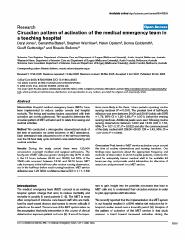Please use this identifier to cite or link to this item:
https://ahro.austin.org.au/austinjspui/handle/1/9985| Title: | Circadian pattern of activation of the medical emergency team in a teaching hospital. | Austin Authors: | Jones, Daryl A ;Bates, Samantha;Warrillow, Stephen J ;Opdam, Helen Ingrid;Goldsmith, Donna;Gutteridge, Geoffrey A;Bellomo, Rinaldo | Affiliation: | Department of Intensive Care, Melbourne University, Austin Hospital, Melbourne, Australia | Issue Date: | 28-Apr-2005 | Publication information: | Critical Care 2005; 9(4): R303-6 | Abstract: | Hospital medical emergency teams (METs) have been implemented to reduce cardiac arrests and hospital mortality. The timing and system factors associated with their activation are poorly understood. We sought to determine the circadian pattern of MET activation and to relate it to nursing and medical activities.We conducted a retrospective observational study of the time of activation for 2568 incidents of MET attendance. Each attendance was allocated to one of 48 half-hour intervals over the 24-hour daily cycle. Activation was related nursing and medical activities.During the study period there were 120,000 consecutive overnight medical and surgical admissions. The hourly rate of MET calls was greater during the day (47% of calls in the 10 hours between 08:00 and 18:00), but 53% of the 2568 calls occurred between 18:00 and 08:00 hours. MET calls increased in the half-hour after routine nursing observation, and in the half-hour before each nursing handover. MET service utilization was 1.25 (95% confidence interval [CI] = 1.11-1.52) times more likely in the three 1-hour periods spanning routine nursing handover (P = 0.001). The greatest level of half-hourly utilization was seen between 20:00 and 20:30 (odds ratio [OR] = 1.76, 95% CI = 1.25-2.48; P = 0.001), before the evening nursing handover. Additional peaks were seen following routine nursing observations between 14:00 and 14:30 (OR = 1.53, 95% CI = 1.07-2.17; P = 0.022) and after the commencement of the daily medical shift (09:00-09:30; OR = 1.43, 95% CI = 1.00-2.04; P = 0.049).Peak levels of MET service activation occur around the time of routine observations and nursing handover. Our findings raise questions about the appropriate frequency and methods of observation in at-risk hospital patients, reinforce the need for adequately trained medical staff to be available 24 hours per day, and provide useful information for allocation of resources and personnel for a MET service. | Gov't Doc #: | 16137341 | URI: | https://ahro.austin.org.au/austinjspui/handle/1/9985 | DOI: | 10.1186/cc3537 | Journal: | Critical Care | URL: | https://pubmed.ncbi.nlm.nih.gov/16137341 | Type: | Journal Article | Subjects: | After-Hours Care.statistics & numerical data Emergency Service, Hospital.utilization Hospitals, Teaching.statistics & numerical data Humans Nursing Staff, Hospital.organization & administration Retrospective Studies Time Factors Victoria |
| Appears in Collections: | Journal articles |
Files in This Item:
| File | Description | Size | Format | |
|---|---|---|---|---|
| 16137341.pdf | 392.82 kB | Adobe PDF |  View/Open |
Page view(s)
34
checked on Nov 18, 2024
Download(s)
102
checked on Nov 18, 2024
Google ScholarTM
Check
Items in AHRO are protected by copyright, with all rights reserved, unless otherwise indicated.
